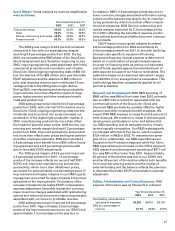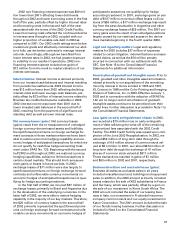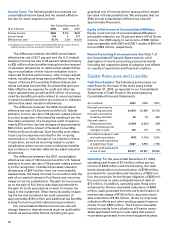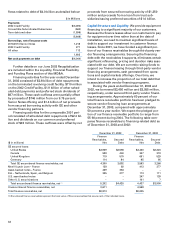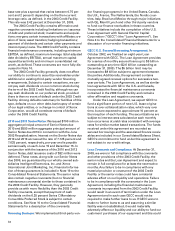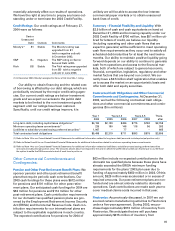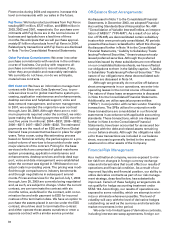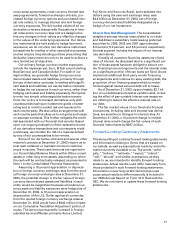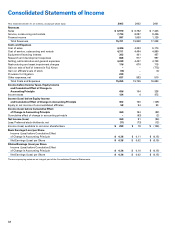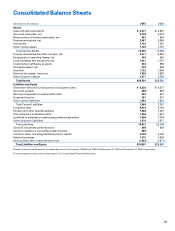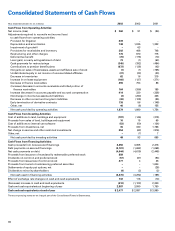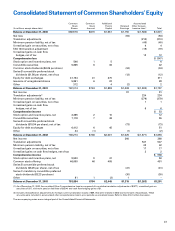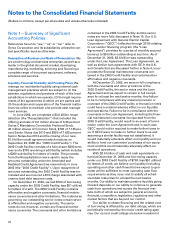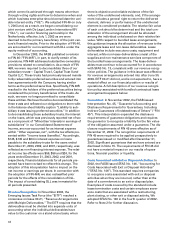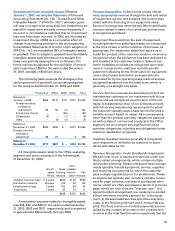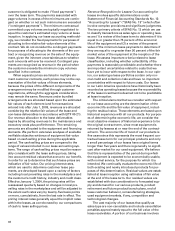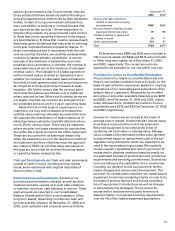Xerox 2003 Annual Report Download - page 39
Download and view the complete annual report
Please find page 39 of the 2003 Xerox annual report below. You can navigate through the pages in the report by either clicking on the pages listed below, or by using the keyword search tool below to find specific information within the annual report.
37
rency swap agreements, cross currency interest rate
swap agreements, forward exchange contracts, pur-
chased foreign currency options and purchased inter-
est rate collars, to manage interest rate and foreign
currency exposures. The fair market values of all our
derivative contracts change with fluctuations in inter-
est rates and/or currency rates and are designed so
that any changes in their values are offset by changes
in the values of the underlying exposures. Our deriva-
tive instruments are held solely to hedge economic
exposures; we do not enter into derivative instrument
transactions for trading or other speculative purposes
and we employ long-standing policies prescribing that
derivative instruments are only to be used to achieve a
very limited set of objectives.
Our primary foreign currency market exposures
include the Japanese yen, Euro, British pound sterling,
Brazilian real, and Canadian dollar. For each of our
legal entities, we generally hedge foreign currency
denominated assets and liabilities, primarily through
the use of derivative contracts. In entities with signifi-
cant assets and liabilities, we use derivative contracts
to hedge the net exposure in each currency, rather than
hedging each asset and liability separately. We typical-
ly enter into simple unleveraged derivative transac-
tions. Our policy is to transact derivatives only with
counterparties having an investment-grade or better
rating and to monitor market risk and exposure for
each counterparty. We also utilize arrangements with
each counterparty that allow us to net gains and losses
on separate contracts. This further mitigates the credit
risk associated with our financial instruments. Based
upon our ongoing evaluation of the replacement cost
of our derivative transactions and counterparty credit
worthiness, we consider the risk of a material default
by any of our counterparties to be remote.
Some of our derivative contracts and several other
material contracts at December 31, 2003 require us to
post cash collateral or maintain minimum cash bal-
ances in escrow. These cash amounts are reported in
our Consolidated Balance Sheets within Other current
assets or other long-term assets, depending on when
the cash will be contractually released, as presented in
Note 1 to the Consolidated Financial Statements.
Assuming a 10 percent appreciation or deprecia-
tion in foreign currency exchange rates from the quot-
ed foreign currency exchange rates at December 31,
2003, the potential change in the fair value of foreign
currency-denominated assets and liabilities in each
entity would be insignificant because all material cur-
rency asset and liability exposures were hedged as of
December 31, 2003. A 10 percent appreciation or
depreciation of the U.S. Dollar against all currencies
from the quoted foreign currency exchange rates at
December 31, 2003 would have a $443 million impact
on our Cumulative Translation Adjustment portion of
equity. The amount permanently invested in foreign
subsidiaries and affiliates, primarily Xerox Limited,
Fuji Xerox and Xerox do Brasil, and translated into
dollars using the year-end exchange rates, was
$4.4 billion at December 31, 2003, net of foreign
currency-denominated liabilities designated as a
hedge of our net investment.
Interest Rate Risk Management: The consolidated
weighted-average interest rates related to our debt
and liabilities to subsidiary trusts issuing preferred
securities for 2003, 2002 and 2001 approximated
6.0 percent, 5.0 percent, and 5.5 percent, respectively.
Interest expense includes the impact of our interest
rate derivatives.
Virtually all customer-financing assets earn fixed
rates of interest. As discussed above, a significant por-
tion of those assets has been pledged to secure ven-
dor financing loan arrangements and the interest rates
on a significant portion of those loans are fixed. As we
implement additional third-party vendor financing
arrangements and continue to repay existing debt, the
proportion of our financing assets which is match-
funded against related secured debt will increase.
As of December 31, 2003, approximately $2.7 bil-
lion of our debt bears interest at variable rates, includ-
ing the effect of pay-variable interest rate swaps we
are utilizing to reduce the effective interest rate on
our debt.
The fair market values of our fixed-rate financial
instruments, including debt and interest-rate deriva-
tives, are sensitive to changes in interest rates. At
December 31, 2003, a 10 percent change in market
interest rates would change the fair values of such
financial instruments by $297 million.
Forward-Looking Cautionary Statements:
This Annual Report contains forward-looking statements
and information relating to Xerox that are based on
our beliefs, as well as assumptions made by and infor-
mation currently available to us. The words “antici-
pate,” “believe,” “estimate,” “expect,” “intend,”
“will,” “should” and similar expressions, as they
relate to us, are intended to identify forward-looking
statements. Actual results could differ materially from
those projected in such forward-looking statements.
Information concerning certain factors that could
cause actual results to differ materially is included in
our 2003 Annual Report on Form 10-K filed with the
SEC. We do not intend to update these forward-looking
statements.


